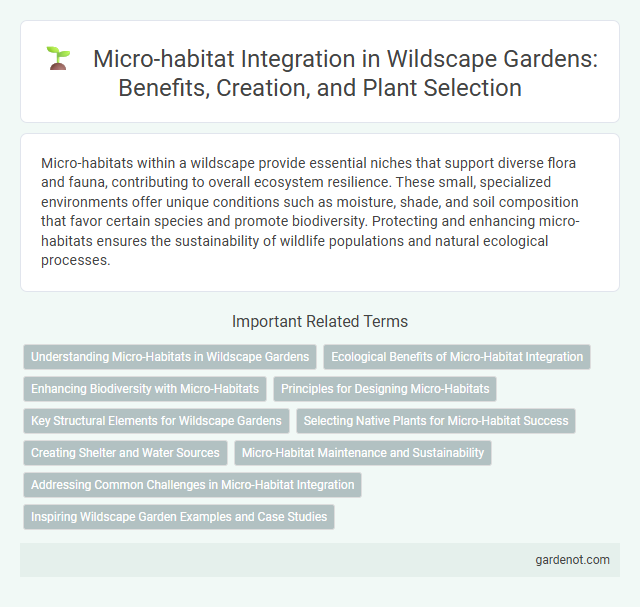Micro-habitats within a wildscape provide essential niches that support diverse flora and fauna, contributing to overall ecosystem resilience. These small, specialized environments offer unique conditions such as moisture, shade, and soil composition that favor certain species and promote biodiversity. Protecting and enhancing micro-habitats ensures the sustainability of wildlife populations and natural ecological processes.
Understanding Micro-Habitats in Wildscape Gardens
Micro-habitats in Wildscape gardens create essential niches that support diverse flora and fauna by mimicking natural environments on a small scale. These specialized zones optimize resources such as sunlight, moisture, and soil conditions, promoting biodiversity and ecological balance within the garden ecosystem. Understanding micro-habitats enhances conservation efforts by fostering habitat complexity and resilience for indigenous species.
Ecological Benefits of Micro-Habitat Integration
Micro-habitat integration within wildscape designs enhances biodiversity by providing specialized niches for a variety of flora and fauna, supporting ecosystem resilience. These micro-habitats improve soil fertility through nutrient cycling and offer natural pest control by attracting predatory insects and birds. The presence of diverse micro-habitats contributes to climate regulation and water retention, promoting overall ecological balance.
Enhancing Biodiversity with Micro-Habitats
Micro-habitats play a crucial role in enhancing biodiversity within Wildscape environments by providing specialized niches for various flora and fauna. These small-scale habitats support diverse species, including insects, amphibians, and small mammals, contributing to ecosystem resilience and stability. Implementing micro-habitats such as log piles, rock crevices, and wildflower patches significantly increases the variety and abundance of native wildlife populations.
Principles for Designing Micro-Habitats
Designing effective micro-habitats in Wildscape involves prioritizing native plant species that provide shelter and food resources tailored to specific wildlife. Structural diversity, such as layered vegetation and varied ground cover, enhances habitat complexity and supports greater biodiversity. Incorporating water access points and minimizing human disturbance are essential principles for sustaining thriving micro-habitats.
Key Structural Elements for Wildscape Gardens
Key structural elements in wildscape gardens include native plants that support local wildlife, water sources such as ponds or rain gardens for hydration and breeding, and varied plant layers that provide shelter and food for insects, birds, and small mammals. Incorporating deadwood and rock piles creates essential micro-habitats for amphibians, reptiles, and invertebrates, enhancing biodiversity and ecological balance. These components collectively establish a thriving environment that sustains diverse species within the wildscape ecosystem.
Selecting Native Plants for Micro-Habitat Success
Selecting native plants that thrive in local soil, sunlight, and moisture conditions is crucial for micro-habitat success in wildscapes. These plants support local wildlife by providing natural food sources and shelter, enhancing biodiversity. Incorporating a variety of native species ensures resilience and ecological balance within the micro-habitat.
Creating Shelter and Water Sources
Creating shelter and water sources within a Wildscape promotes biodiversity by providing essential micro-habitats that support various species' survival needs. Strategically placing natural materials such as logs, rocks, and dense vegetation forms protective shelters while installing shallow water basins or ponds encourages hydration and attracts wildlife. These micro-habitat elements foster ecological balance and enhance the habitat's overall resilience.
Micro-Habitat Maintenance and Sustainability
Micro-habitat maintenance in Wildscape involves preserving essential environmental conditions such as soil quality, moisture levels, and native vegetation to support diverse species. Implementing sustainable practices like controlled grazing, selective planting, and habitat restoration minimizes ecological disruption and promotes long-term biodiversity. Continuous monitoring using ecological indicators ensures adaptability and effectiveness in sustaining micro-habitat health within the Wildscape ecosystem.
Addressing Common Challenges in Micro-Habitat Integration
Wildscape projects face challenges in micro-habitat integration such as limited space, varying microclimates, and species-specific habitat requirements. Effective design strategies include creating layered vegetation, using native plant species, and incorporating water features to mimic natural ecosystems. Monitoring and adaptive management ensure resilience and biodiversity within these finely tuned ecological niches.
Inspiring Wildscape Garden Examples and Case Studies
Micro-habitats in Wildscape gardens showcase diverse ecological niches, supporting native flora and fauna while enhancing biodiversity. Inspiring examples include vertical moss walls and pollinator-friendly flower clusters that create sustainable ecosystems in limited spaces. Case studies reveal increased urban wildlife activity and improved soil health, demonstrating the ecological benefits of integrating micro-habitats into garden design.
Micro-habitat Infographic

 gardenot.com
gardenot.com